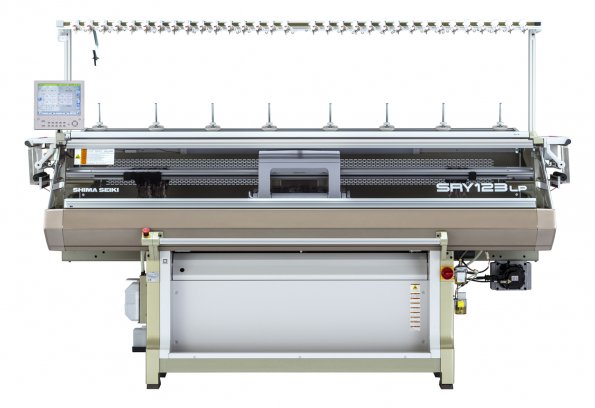
Global sales of flat knitting machines increase by 44%
According to the ITMF report, shipments in most of the textile machinery segments, except flat knitting machinery, experienced declines in 2014.

10th June 2015
Knitting Industry
|
Zurich
Shipments of flat-knitting machines rose by 31% from 2013 to 2014, whilst other textile machinery segments experienced negative growth, according to the 37th annual International Textile Machinery Shipment Statistics (ITMSS) released by the International Textile Manufacturers Federation (ITMF).
The report covers six segments of textile machinery, namely spinning, draw-texturing, weaving, large diameter circular knitting, flat knitting, and finishing machinery. The 2014 survey has been compiled in cooperation with 117 textile machinery manufacturers.
Shima Seiki SRY123LP flat knitting machine. Over 85% of all flat knitting machine deliveries went to Asia with China being the largest investor. However, high-tech machines such as Shima's SRY123LP were popular in markets such as Italy. (c) Shima Seiki.
The report shows that except flat knitting machinery, shipments in most of the textile machinery segments experienced declines in 2014. Deliveries of new short-staple spindles fell by 15% from 2013 to 2014. Shipped long-staple spindles and open-end rotors increased by 70% and 2.6% respectively. The number of shipped draw-texturing spindles grew by close to 12%. Shuttle-less looms and new large circular knitting machines also dropped by 14% and 22%.
Global shipments of large diameter circular knitting machines fell by 22% from 36,575 in 2013 to 28,502 in 2014, the lowest level since 2009. Also for this category Asia is the world’s leading investor. Nearly 88% of all circular knitting machines are shipped to Asia and with a share of 60% (close to 17,000 shipments) of worldwide deliveries China is the single largest investor. India and Turkey rank second and third with 2,464 (8.6%) and 1,325 units (4.6%) respectively.
However, 2014 was a good year for the segment of electronic flat knitting machines as global shipments grew by 31% to 46,100 machines. This was the first increase since 2011.
Over 85% of all deliveries went to Asia with China being the largest investor with a share of 42% equivalent to over 19,000 units. Including China, four of the five largest investors for flat knitting machines are Asian countries. Second and third are Bangladesh (11,312 units) and Vietnam (1,956). Turkey ranks fourth, and India is fifth.
Shipments of new short-staple spindles fell by 15% in 2014 year-on-year and more than reversed the increase of 10% in 2013. The level of short staple spindles declined to 9.8 million spindles, which is the lowest level since 2009, and is also lower than the ten-year-average of 10.9 million.
Global shipments of long-staple (wool) spindles increased by 70% to 137,650 in 2014. That is the strongest increase since 2012. The majority of long-staple spindles (69%) were shipped to Europe.
Shipments of open-end rotors improved moderately in 2014 by 2.6% after they declined in the previous two years. The number of shipments reached 454,720, the highest level since 2011 and well above the long-term average of 402,669.
Global shipments of single heater draw-texturing spindles (mainly used for polyamide filaments) increased by 76% from 2,600 in 2013 to 4,576 in 2014. With nearly 57% Asia is the region where most of the single heater draw-texturing spindles were shipped to followed by Western Europe with 20% and South Amercia with close to 15%.
In the segment of double heater draw-texturing spindles (mainly used for polyester filaments) the downward trend continued and global shipments fell by 12% on an annual basis to 443,352. However, the pace of decline moderated somewhat compared to 2013 when shipments fell by nearly 30%.

Business intelligence for the fibre, textiles and apparel industries: technologies, innovations, markets, investments, trade policy, sourcing, strategy...
Find out more